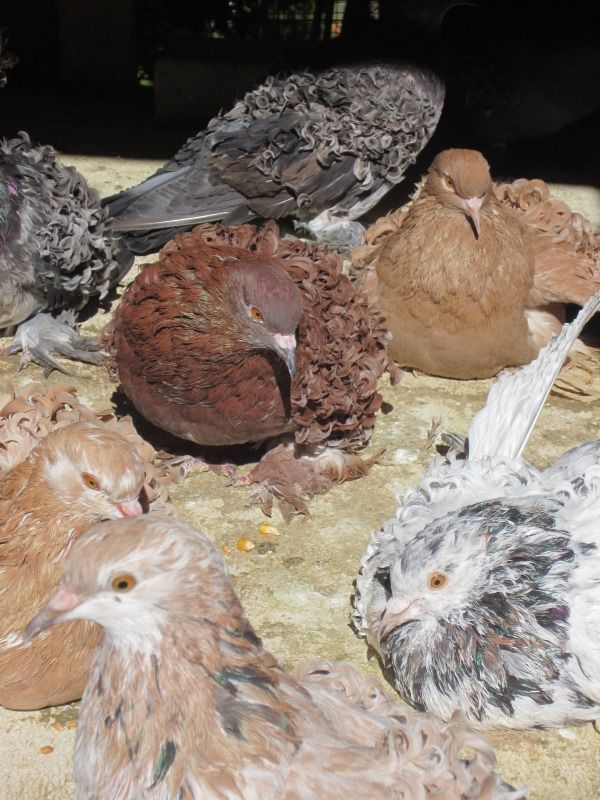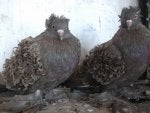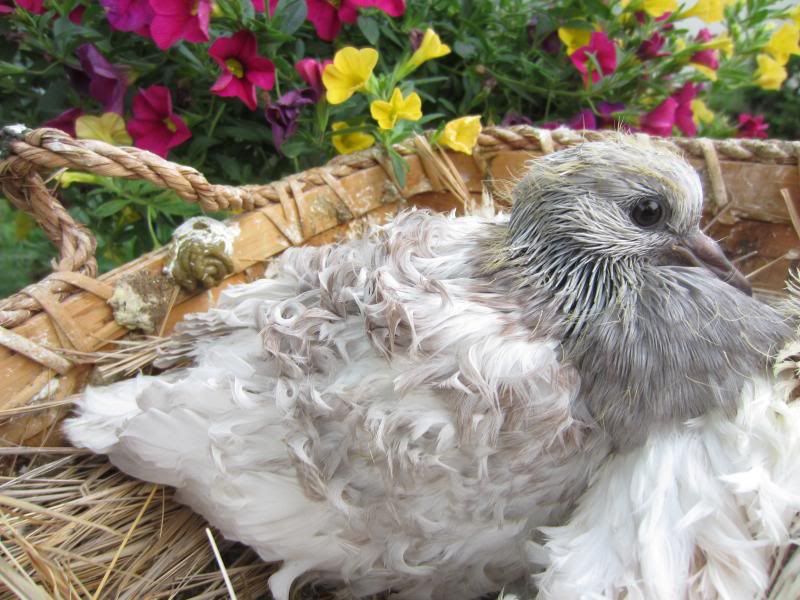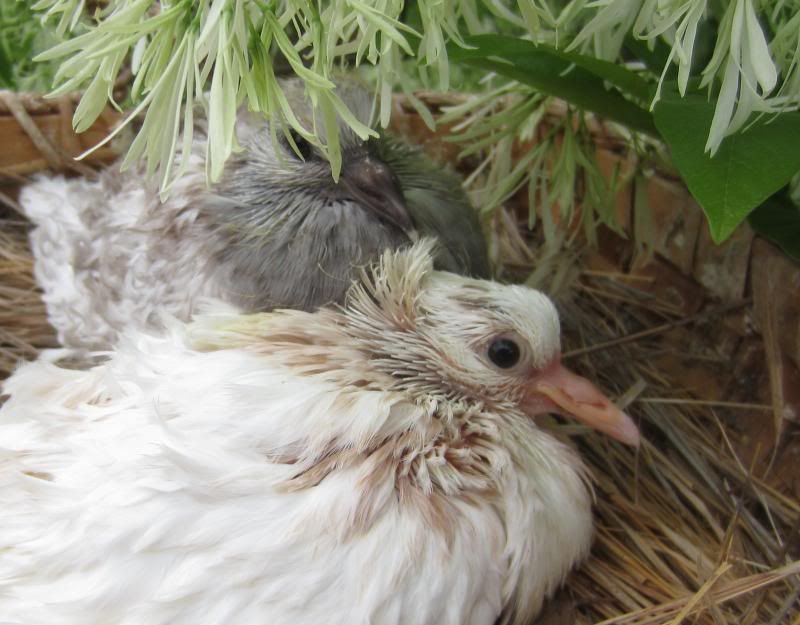This thread is for Frillback discussion, pictures, information, links and questions.
I will start off with this old article from 1909
The Frillback Pigeon.
By Elmer R. B. Chapman.
The Present Day Frillback Standardized.
The Frillback, as we in America know it, is a large dove-
house sort of a pigeon, very awkward in shape, having a long
spindly, downward curved beak.
There are three or really two distinct varieties, as the
Clean Legged are similar to the other two with the exception
of having no feathers on their shanks and feet.
The white or variety said to have originated in Holland
which we call the Dutch is' a very beautiful bird. ' It should
be as near the engraving shown herewith as 'possible. .
Having a plump massive shape, shell crest, long frilled
muffs, also frills as near covering the birds as possible. In the
frilling is their beauty, a good specimen looking almost as if
they had been curled with a curling iron. The author has never
seen a Dutch Frill in any other color other than white that had
this point to perfection.
For this very reason a very white nicely frilled specimen of
this variety can stand no comparison with the Austrian or
German variety. These we find in all colors, including Bell-
necks and Grizzles.
A well frilled, grizzled Frillback is a very beautiful bird. A
Bellneck Austrian should be a medium sized bird with grouse
muffs, all white, excepting a colored bib, narrow across the neck,
with crescent over the crop. The frilling should extend well over
the sides and up the back.
A grizzle should be well mixed all over, being black, blue, red
or yellow combined with pure white.
A solid color should be solid, of uniform color, very bright,
with a brilliant sheen.
Prillbacks are very hardy and good feeders, but for results,
they should always be kept in a separate loft. They also have
another property which recommends them very highly to any
fancier who keeps his birds without an aviary. That is, they
entirely lack the homing instinct. The author has imported
birds and allowed them to fly at large within 48 hours after re-
ceiving them and never lost a bird.
So much for a general description. Now what is the
standard requirement tor which we must breed to win in the
show room? Unfortunately this variety has not as yet been
taken up by any club, nor any fixed standard been formulated.
A Pair of Blue Grizzle Austrians
The idea has always been and really how could it be other-
wise at present. The best frilled specimen to win, irrespective
of type or color. Most judges under which my birds have been
shown have never before even seen a modern Frillback.
The standard which I believe should be used is as follows,
and as some of the Frillback breeders may differ from me in
their views, if they will differ aloud, the breed will surely make
progress.
Breast— rounded and projecting beyond the wing butts.
Legs — of medium length, birds should not have a crouchy
appearance.
Varieties.
Dutch. All white with long well developed muffs.
Austrian or German.
All as per above standard with the exception that they
should have evenly muffed (grouse) legs.
Clean legged. All as above without any trace of feathers
on shanks and feet.
Feather. Abundant but quite closely fitting.
Frilling. The feathers over wing covering, saddle and back
as far up 'the neck as possible should be frilled. The longer
the frills the better tlje bird. These curls or frills to be as
symmetrical as possible.
Shape — cobby.
Head — dove headed, rather low with long convex crown.
Beak — slender, rather long and straight, slightly curved
downward. Color white in whites, and dark in all other varie-
ties.
Wattle — very small and smooth, with natural whitish bloom.
Eye cere — thin and fine in texture, white in white and dark
in all other varieties.
Byes — bull in whites, orange in all other colors except Bell-
nscks, which are preferred pearl.
Neck — of medium thickness.
Shoulders — broad and full.
Color.
Selfs. All colors.
Bellnecks. All white except the wing bars, and a crescent
or band around the neck.
Grizzles. All colors. A good grizzle should be grizzled all
over.
Ermlnettes. White peppered with black. Tails colored in all
varieties except the white. Very bright in coloring.
Crest. All Dutch Frills should have a shell crest extending
from eye to eye, rising about a 1-4 inch over the cap, showing
cup-like cavity but not resting on or touching the head.
This, I believe, should he the standard of the modern Frill-
back. What we need is a Frillhack Club to push this variety,
and place It where it belongs as one of the most beautiful of the
toy varieties.
Having bred Frillbacks for over 20 years, and being often
asked if there are any settled breeding rules, I will give you a
few of my own.
1st. Never mate any except a well frilled cock. The cock
throws the frilling properties every time.
2nd. Don't cross the Dutch with the Austrian.
3rd. In breeding Bellnecks, breed from those having the
darkest wing barring and (he lightest shoulders.
A Yellow Grizzle Austrian Hen.
, 4th. Don't cross the colors expecting great results. Bred
from ages as this bird has been without regard other than that
of frill, colors have got sadly mixed. Almost any color is liable
to crop out.
5th. In breeding grizzles, breed the best grizzles together
or cross a solid color onto a white, never onto a grizzle.
6th. Don't put a clean leg with a grouse or long muffed
bird and expect to get that even beautiful muff.
I am well aware that as there are fanciers that cannot abide
the Pouter with its stockings, but who think the Cropper perfection, also others who cannot fancy the Tumbler with wings on
its feet, but who dote on its cleaned legged prototype, so there
are fanciers who are working on the clean legged Frillback.
It is true there are clean leg Frills. The author owns a few
himself. Fine in color without a stub. But way, way back in
comparison with the muffed birds. I am also aware that Fulton
describes the Frill as a clean leg. I still contend that a frill if
obtained anywhere near the cut, cannot be improved.
In showing Frillback I have noticed that gently winding the
bird with a damp towel tends to increase the frills, also that
birds show to a much better advantage in damp, moist weather,
rather than when it is hot and dry.
Let the Frillback fanciers get together, talk and boom the
Frillback. It can be easily made one of the most popular of the
Fancy Pigeons. Let us hear from you. Don't keep your birds at
home. Fill the classes at the different shows chock full with
bird to spare. Let's have a Frillback specialty club.
Wake up, fanciers of the Frillback!
What is a Frillback?
Why was it so named?
Of course I believe a Frillback should be a pigeon having
an abundance of frill extending as far up the back as possible,
being as its name signifies, a Frillback. But is that all? Take
for instance the Black Mottle C-Leg Tumbler. Why, the very
mention of the word shows us what we should expect, — a black
pigeon mottled as per the Standard without a trace of stubs on
its shanks or feet and the true tumbler type.
But no, most everyone thinks that a Frillback is any sort of
a pigeon having curly feathers or frills.
The one having the most should always win 1st, irrespective
of shape or type, feather, eye, etc.
Again I say, get together and compel the judges to judge
them properly.
How often are we at the present time put in the left-over
class, that is, any judge who may not be otherwise engaged is
set to judging our birds?
What does a man who has bred Tumblers all his life, (al-
though he may be, I warrant you, a good Tumbler judge) know
concerning our birds?
Has he ever bred or handled any outside of the show room?
At the beginning we should get at the Show Committees,
as the classes allowed us are first of all too wrong. They
should not be White or any other color, but hatch which is a
distinctly crested, long-booted bird, Austrian, which is an en-
tirely different type, with even grouse muffs.
If classes are sub-divided, there should be the Grizzle, the
Bell-Neck and Solid.
As to frills — acting as judge over many classes — I say that
the best all round bird should win. But supposing that we have
only one Frillback class — all colors and kinds competing — why
then I say the best frilled specimen ought to win.
Now again what is the best frilled specimen? The frill is
in the shape accurately described as similar to a steel shaving
thrown from a drill, a good frill having that beautiful spiral
and holding it too.
A bird is not a good frilled specimen just because his feathers are rough and do not lay smooth. The frills should be
distinct and stand clearly away from the bird and not look like
rumpled feathers.
I will start off with this old article from 1909
The Frillback Pigeon.
By Elmer R. B. Chapman.
The Present Day Frillback Standardized.
The Frillback, as we in America know it, is a large dove-
house sort of a pigeon, very awkward in shape, having a long
spindly, downward curved beak.
There are three or really two distinct varieties, as the
Clean Legged are similar to the other two with the exception
of having no feathers on their shanks and feet.
The white or variety said to have originated in Holland
which we call the Dutch is' a very beautiful bird. ' It should
be as near the engraving shown herewith as 'possible. .
Having a plump massive shape, shell crest, long frilled
muffs, also frills as near covering the birds as possible. In the
frilling is their beauty, a good specimen looking almost as if
they had been curled with a curling iron. The author has never
seen a Dutch Frill in any other color other than white that had
this point to perfection.
For this very reason a very white nicely frilled specimen of
this variety can stand no comparison with the Austrian or
German variety. These we find in all colors, including Bell-
necks and Grizzles.
A well frilled, grizzled Frillback is a very beautiful bird. A
Bellneck Austrian should be a medium sized bird with grouse
muffs, all white, excepting a colored bib, narrow across the neck,
with crescent over the crop. The frilling should extend well over
the sides and up the back.
A grizzle should be well mixed all over, being black, blue, red
or yellow combined with pure white.
A solid color should be solid, of uniform color, very bright,
with a brilliant sheen.
Prillbacks are very hardy and good feeders, but for results,
they should always be kept in a separate loft. They also have
another property which recommends them very highly to any
fancier who keeps his birds without an aviary. That is, they
entirely lack the homing instinct. The author has imported
birds and allowed them to fly at large within 48 hours after re-
ceiving them and never lost a bird.
So much for a general description. Now what is the
standard requirement tor which we must breed to win in the
show room? Unfortunately this variety has not as yet been
taken up by any club, nor any fixed standard been formulated.
A Pair of Blue Grizzle Austrians
The idea has always been and really how could it be other-
wise at present. The best frilled specimen to win, irrespective
of type or color. Most judges under which my birds have been
shown have never before even seen a modern Frillback.
The standard which I believe should be used is as follows,
and as some of the Frillback breeders may differ from me in
their views, if they will differ aloud, the breed will surely make
progress.
Breast— rounded and projecting beyond the wing butts.
Legs — of medium length, birds should not have a crouchy
appearance.
Varieties.
Dutch. All white with long well developed muffs.
Austrian or German.
All as per above standard with the exception that they
should have evenly muffed (grouse) legs.
Clean legged. All as above without any trace of feathers
on shanks and feet.
Feather. Abundant but quite closely fitting.
Frilling. The feathers over wing covering, saddle and back
as far up 'the neck as possible should be frilled. The longer
the frills the better tlje bird. These curls or frills to be as
symmetrical as possible.
Shape — cobby.
Head — dove headed, rather low with long convex crown.
Beak — slender, rather long and straight, slightly curved
downward. Color white in whites, and dark in all other varie-
ties.
Wattle — very small and smooth, with natural whitish bloom.
Eye cere — thin and fine in texture, white in white and dark
in all other varieties.
Byes — bull in whites, orange in all other colors except Bell-
nscks, which are preferred pearl.
Neck — of medium thickness.
Shoulders — broad and full.
Color.
Selfs. All colors.
Bellnecks. All white except the wing bars, and a crescent
or band around the neck.
Grizzles. All colors. A good grizzle should be grizzled all
over.
Ermlnettes. White peppered with black. Tails colored in all
varieties except the white. Very bright in coloring.
Crest. All Dutch Frills should have a shell crest extending
from eye to eye, rising about a 1-4 inch over the cap, showing
cup-like cavity but not resting on or touching the head.
This, I believe, should he the standard of the modern Frill-
back. What we need is a Frillhack Club to push this variety,
and place It where it belongs as one of the most beautiful of the
toy varieties.
Having bred Frillbacks for over 20 years, and being often
asked if there are any settled breeding rules, I will give you a
few of my own.
1st. Never mate any except a well frilled cock. The cock
throws the frilling properties every time.
2nd. Don't cross the Dutch with the Austrian.
3rd. In breeding Bellnecks, breed from those having the
darkest wing barring and (he lightest shoulders.
A Yellow Grizzle Austrian Hen.
, 4th. Don't cross the colors expecting great results. Bred
from ages as this bird has been without regard other than that
of frill, colors have got sadly mixed. Almost any color is liable
to crop out.
5th. In breeding grizzles, breed the best grizzles together
or cross a solid color onto a white, never onto a grizzle.
6th. Don't put a clean leg with a grouse or long muffed
bird and expect to get that even beautiful muff.
I am well aware that as there are fanciers that cannot abide
the Pouter with its stockings, but who think the Cropper perfection, also others who cannot fancy the Tumbler with wings on
its feet, but who dote on its cleaned legged prototype, so there
are fanciers who are working on the clean legged Frillback.
It is true there are clean leg Frills. The author owns a few
himself. Fine in color without a stub. But way, way back in
comparison with the muffed birds. I am also aware that Fulton
describes the Frill as a clean leg. I still contend that a frill if
obtained anywhere near the cut, cannot be improved.
In showing Frillback I have noticed that gently winding the
bird with a damp towel tends to increase the frills, also that
birds show to a much better advantage in damp, moist weather,
rather than when it is hot and dry.
Let the Frillback fanciers get together, talk and boom the
Frillback. It can be easily made one of the most popular of the
Fancy Pigeons. Let us hear from you. Don't keep your birds at
home. Fill the classes at the different shows chock full with
bird to spare. Let's have a Frillback specialty club.
Wake up, fanciers of the Frillback!
What is a Frillback?
Why was it so named?
Of course I believe a Frillback should be a pigeon having
an abundance of frill extending as far up the back as possible,
being as its name signifies, a Frillback. But is that all? Take
for instance the Black Mottle C-Leg Tumbler. Why, the very
mention of the word shows us what we should expect, — a black
pigeon mottled as per the Standard without a trace of stubs on
its shanks or feet and the true tumbler type.
But no, most everyone thinks that a Frillback is any sort of
a pigeon having curly feathers or frills.
The one having the most should always win 1st, irrespective
of shape or type, feather, eye, etc.
Again I say, get together and compel the judges to judge
them properly.
How often are we at the present time put in the left-over
class, that is, any judge who may not be otherwise engaged is
set to judging our birds?
What does a man who has bred Tumblers all his life, (al-
though he may be, I warrant you, a good Tumbler judge) know
concerning our birds?
Has he ever bred or handled any outside of the show room?
At the beginning we should get at the Show Committees,
as the classes allowed us are first of all too wrong. They
should not be White or any other color, but hatch which is a
distinctly crested, long-booted bird, Austrian, which is an en-
tirely different type, with even grouse muffs.
If classes are sub-divided, there should be the Grizzle, the
Bell-Neck and Solid.
As to frills — acting as judge over many classes — I say that
the best all round bird should win. But supposing that we have
only one Frillback class — all colors and kinds competing — why
then I say the best frilled specimen ought to win.
Now again what is the best frilled specimen? The frill is
in the shape accurately described as similar to a steel shaving
thrown from a drill, a good frill having that beautiful spiral
and holding it too.
A bird is not a good frilled specimen just because his feathers are rough and do not lay smooth. The frills should be
distinct and stand clearly away from the bird and not look like
rumpled feathers.








